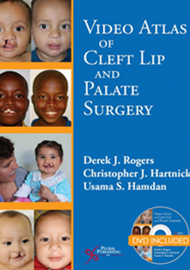This is a well written textbook containing the basic background information and surgical techniques involved in cleft lip and palate surgery. The information is bestowed upon the reader in a clear, concise and logical way whilst being supplemented by sharp patient photographs and diagrams.
These images are arguably one of the biggest strengths of this textbook as they are presented in such a manner that aids the reader in understanding an often difficult to comprehend subject. Furthermore a DVD is enclosed with the publication providing high quality real time video footage of the topics and procedures discussed in the textbook.
The surgical techniques for each repair are given in a concise manner initially outlining the goals, indications, equipment, anaesthesia and then the procedure itself. This is followed up by postoperative considerations and possible complications. As a result the chapters are easy to read in a sequential manner.The surgical procedure itself is given in a succinct step-by-step manner starting with initial skin marking and proceeding to the incisions and subsequent repair.
However, in many instances the surgical techniques presented constitute only a narrow spectrum of the potential repair options and instead appear to represent the authors’ preferred technique rather than a global overview. An example of such is that there is no mention of radical muscle dissection and the repositioning technique described by Sommerlad which has become so popular in this country in terms of cleft palate repair.
The textbook thankfully does not focus only on the perioperative surgical approaches to managing patients with a cleft lip and / or palate. It encompasses the medical / surgical pre and postoperative aspects of care but also the contribution of various allied healthcare professionals involved in the multidisciplinary team essential to providing a good standard of care for these patients. It is also reassuring to see that the topic of velopharyngeal insufficiency has not been overlooked by this text in terms of evaluation and non-surgical and surgical options. The closing chapters of the book provide a nice focus on this important topic.
This textbook is an excellent resource for any plastic / ENT / maxillofacial surgery trainee, particularly in the run-up to fellowship exams. I can highly recommend it as a reference text to come to grips with the basic principles and some of the techniques available for repair.




